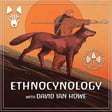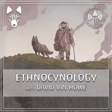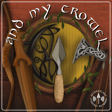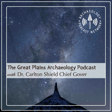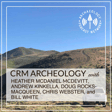Become a Creator today!Start creating today - Share your story with the world!
Start for free
00:00:00
00:00:01

How I created Ethnocynology (Part 1) - Ep 01
In this premiere episode of Ethnocynology with David Ian Howe, David speaks for 30 minutes straight with almost 0 pauses about his favorite subject—Ethnocynology. As well as the Colombian Exchange.
David begins by defining archaeology and Ethnocynology, and what they mean to him. Which then leads him to discussing what led him to studying the subject in general. Which he breaks into three parts:
Taking an intro to anthropology course
A history documentary called “Mankind”
A zooarchaeology class and a documentary about the flight distance hypothesis
He then rants about species, speciation, and how naming things can be problematic. This episode will be continued and clarified in episode 2.
Transcripts
- For rough transcripts of this episode, go to: https://www.archpodnet.com/ethno/01
Contact
- David Ian Howe: davidianhowe.com
ArchPodNet
- APN Website: https://www.archpodnet.com
- APN on Facebook: https://www.facebook.com/archpodnet
- APN on Twitter: https://www.twitter.com/archpodnet
- APN on Instagram: https://www.instagram.com/archpodnet
- Tee Public Store
Transcript
Introduction: Anthropology and Archaeology
00:00:00
Speaker
You're listening to the Archaeology Podcast Network.
00:00:12
Speaker
Welcome to the Ethnocynology podcast. My name is David Ian Howe. I'm an anthropologist and an archaeologist in the United States. Archaeology is just part of anthropology, but and essentially an anthropologist is a scientist who studies the human species, either scientifically humanistically, like whatever word you want. it I'll just go with scientifically. That's what I do and not to confuse people. But on the subset of anthropology is also archaeology. So understanding the human species through material culture and their material remains, physical remains, and I would kind of describe that as
00:00:52
Speaker
How would I describe that, David? That would be, talking to myself now, that would be, you know, understanding human culture through time is what you're doing with the artifacts, right? So it's not just robbing Egyptian temples or actually carefully excavating Egyptian temples or Mayan temples or Stonehenge. You're carefully excavating things to understand human behavior in the past.
Ethnocynology: Dogs in Human Culture
00:01:13
Speaker
But ethnocynology, which is what this podcast is, is ah the study of dogs in human cultural contexts. So essentially,
00:01:22
Speaker
dog anthropology is how I would describe that. Oh, by the way, for those listening, I am on Instagram live here so people can shoot me questions if they have it, if I remember to look at it because it's here. Ethnocynology is the study of dogs in human cultural context. So, essentially, dog anthropology and when you study dogs anthropologically in this sense, like you will find that dogs are pretty intertwined with human history for at least all of written history dogs have been around and even a lot of prehistory dogs have been around so into the Mesolithic, certainly the Neolithic and and modern day, but in the Paleolithic dogs have been around genetically for 20,000 years, but I have no doubt it's way longer than that, just as long as humans and wolves have been interacting. So in this first episode, I kind of just wanted to talk about
00:02:12
Speaker
how I got into this because I've been on meat eater. I did a thing with PBS. I did a thing with Ted. I did a thing with not to like sit here and brag, but it's just like kind of overwhelming of like how many times I've discussed this and never just directly discussed it with my own audience. So how I got into this would be Essentially, I just always liked dogs. There's that. that's That's the first option. Do I have the questions done here yet? Oh, someone said Daniel, vi wow. Somebody knows that I also did one with Daniel Vitalis. He was on Wildfed is his podcast too. So I get i asked to be on a lot of hunting podcasts and a lot of foraging and a lot of outdoor podcasts because it kind of goes hand in hand. And that's another thing that I really like is being outside. I'm wearing like an outdoor handmade vest right now, if you're watching the video.
00:02:57
Speaker
but Yeah, being outside is a huge thing that led me to archaeology. Part of archaeology is like being outside a lot. You know, like you got to be intense. You got to it's sweaty. You're in the sun. I refuse to do archaeology in the south ever again because it's you just essentially.
00:03:14
Speaker
digging through the jungle and in Georgia and like parts of Tennessee. My field school was in Tennessee so in the middle of July and August and it was really hot. I'm digressing from the thing but I like it out here out west because you can see things basically on the ground as they were left 10,000 years ago. You don't have to dig too many holes and when you do find stuff that's when you dig holes and that will be future episodes we can get into the nitty-gritty of digging through net and grit. That was bad. ah But why I got into ethnocynology was there's just so many ways to get to this answer. I just, essentially I got to archeology. I started with history. I went to school for history at
Rethinking Historical Timelines
00:03:53
Speaker
first and I was like, wow, I love reading six books a week for history about reconstruction in the United States. Like that, I love this so much. And then I took an anthropology class and it was about primates and it was about stone tools and it was about
00:04:07
Speaker
human evolution and culture. And I was like, oh shit, this is what I like. this This is definitely it. So I took that because what I was really interested in, and this is a new lecture I'm working on, is a um like the exchange. So pre-1492 and post-1492. And I've argued this on my stories. I've tweeted this before. BC and AD is just dumb to me. like it's It's old. like Even when we go, oh, it's CE.
00:04:35
Speaker
The BCE now, the common era, before come it still revolves around Jesus. I think a more significant time period, like a time shift in our human history is 1492, when not because Columbus discovered America, but just because of the just explosion of human trade, human behavior changes constantly.
00:04:56
Speaker
Western Hemisphere then gets brought thrust out of the Stone Age into whatever, you know, you want to call it the Steel Age of Exploration. I guess technically when the Spanish first got to the Americas, it was late medieval, but we don't have to get bogged down at the time periods because that's what old archaeologists do. New archaeologists worry more about rocks and science. But I was really interested in that and I understood like I was really into the culture, the culture clash, right, of the Spanish meeting with the the ancient Mexico or the the classical Mexico, the Aztecs and the Maya, Jamestown, like how the British interacted with the natives that were here. Why is South America like very mixed with like what would I guess be called mestizo or like, you know, mesta, mesta jaje, like the
00:05:42
Speaker
mixed race stuff, whereas like in North America, it's just like everyone's white, like the natives were all like gone because the British colonized later, Spanish colonized earlier. That's the whole thing. You can get into that. But a lot of, you know, young men, second sons came over to the US and like business people came to the, I'm sorry, to the Americas to start.
00:06:01
Speaker
you know, uh, their businesses, right? Cause like colonizing was a business at first. You're just like coming here to get land. You're not coming here to look for gold. They definitely weren't coming here to look for God and glory, I guess could be part of it, but really what they wanted was land and business. So that'll happen. And then like a hundred, 200 years later is when the U S really started like picking up or what is now the U S and that's like,
00:06:22
Speaker
I'm getting into the weeds of this, but I want to talk about dogs. But one thing i've I've pointed out on many podcasts is that when the Spanish got to the Americas and the French explored like the interior of the Americas, or North America at least, and the British, was they noted that natives had dogs. Lots of information on it. Buffalo Bird Woman was a lot later in time, but she was One of the reasons we know about dog travois and like how dogs were like raised by mostly women and young children, how the the harnesses were tied to them, how they were used to pull things. Like we have stuff from that before this again, 1492, there's a whole thing with, you know, did horses exist in the Americas before
00:07:04
Speaker
the arrival of Europeans, there's like oral evidence that there was, but there's not anything for physical evidence. So I go with the archaeological, there was
Impact of Colonization on Dog Genetics
00:07:13
Speaker
none. So that way when the horse got here, a lot of culture shifted from like the horse time to the dog time or vice versa. Sorry, the dog time to the horse time. That's significant. Dogs were the only really huge beasts of burden here when comparison to a turkey. Lamas in South America were high up in the Andes, didn't really help people in Virginia, but dogs did. So that's a unifying thing between the old world and the new world. And I know those are kind of complicated words to use now, but I guess I'm just trying to say the Western and the Eastern hemispheres.
00:07:44
Speaker
was 1492 was that big change. And like a a unifying factor between humans on both sides of the planet was that they had domestic dogs. And Cook noted that. Spanish journals noted that. The French noted that. And one thing that came out, I believe it was 2020. 2019, 2020. Study by Dr. Angela Perry. We're about to genetic. And this is, again, this all ties into Why I'm interested in this stuff, the essentially when all the Europeans brought their dogs over here and I'm not trying to be like Europeans are bad. I'm just saying like this is just a fact of what happened that there's just no more indigenous dog DNA. Like there's some, but there's just not.
00:08:23
Speaker
A substantial amount, the overwhelming majority of dogs in Mexico, Brazil, Peru, Argentina, Florida, Montana, it's all European dog DNA. Even the Chihuahua and the Xolo, or the Xolo, Xolo, however you want to say it, that's like been bred with European dogs or like, you know, just intermixing because dogs.
00:08:43
Speaker
do dog stuff in a certain style and reproduce, wink. And that happened a lot and you can't really control it. So like the jogs kind of the European dogs kind of overwhelmingly took over the indigenous dog DNA, which is essentially what happened to Neanderthals. It's not like we went through and like bludgeoned every last Neanderthal or bludgeoned every last Chihuahua sound effect. There's just the dogs had a lot of sex with the native chihuahuas, and we had a lot of sex with Neanderthals, and that's why they're gone, but they're still like part of us. So anyway, that study kind of talked about how like you would think the Carolina dog, like the American Dingo, the Chihuahua, and like the Greenland dog would have a lot more indigenous DNA, but it's like a pretty tainted with European DNA. So dogs are a pretty interesting way to look at that.
00:09:32
Speaker
And I went on a whole tangent on the Columbian Exchange, which will frequently happen on this podcast, so get used to that. But ah why I got into it was just because of the reason I went on that tangent. I just find that period of time so fascinating. And I went to school for history, took those anthropology classes, and was like, oh, this is what I'm interested in, that culture clash, that exchange of genetics, that exchange of ideas, and things like that.
00:09:58
Speaker
And then I got really into stone tools because, you know, I was the type of kid, like, stickuey I think you're watching right now, too, like the. I was in the military stuff like I had swords, I had katanas, I did martial arts for years. Like I was always every kid's into that. I played Rome Total War. Hashtag Guy Flavius. Shout out. Did all that stuff. And I was really into that. And then when I took an anthropology class and I saw like. They like made these out of rocks.
00:10:24
Speaker
So I was like super into that. And again, like the central Mexico, the people there were throwing like stone tipped darts at conquistador or lookslessly Spanish colonists, Spanish military people wearing their like full on armor and stuff like that. And you know, mostly it was, especially in the siege of Tenochtitlan, it was like a lot of indigenous versus indigenous, but still the Spanish did get a couple darts thrown their way here and there. But I loved that culture clash.
00:10:52
Speaker
And I was really into stone tools and I was into like that ice age stuff. I loved being outside and I went to, I switched schools from UT Chattanooga, University of Tennessee Chattanooga to University of Tennessee Knoxville because they had a much bigger anthropology program. And you might be familiar with like the body farm is there, like the big forensic anthropology center. They don't like it when you call it the body farm, but that's what people know it as. I used to work there as an intern.
00:11:18
Speaker
was pretty cool smelled real bad i also saw a raccoon eat someone's toe just like a dead body just to hop the fence, shoot on a toe, left with it. It was pretty cool. And I was like, I'm going to get my master's in this. So then I went to my master's program in Wyoming for hunter-gatherer archaeology and behavioral ecology. And that is studying humans or zoological entities, right? We came to Manamalia, Cordata. We have spines. We're in Mammalia, because we have breasts that breastfeed, which Mammalia, or mammals.
00:11:53
Speaker
We feed our young, and then in that, we are in the order of primates, which means we have grasping hands and are very social. We're different than rodents. We're different than carnivorans, like cats and dogs. So that's where we all split, is into carnivorans or cats, dogs, seals. Primates are humans, you know lemurs, monkeys, apes, tarsiers, all
Human Nature Through a Zoological Lens
00:12:13
Speaker
that. And then rodents are their own thing. and i would say like we're I guess we're all kind of closer later than that sense.
00:12:18
Speaker
But humans are a zoological species. And what I learned in graduate school, which is like, people think of archaeology as like, oh, you're just like grave robbing in Egypt or like, you know, you're digging a hole or, you know, excavating some bricks of a Roman mosaic. But actually what I do is like, and I try to frame this as much as I can when I'm on these podcasts is like,
00:12:41
Speaker
I study humans zoologically, where zoological entities, humans behave zoologically on a landscape, whether you want to believe that or not. People need to have food, ah they need to get food, they need to eat food to sustain their bodies and create energy, and they want to reproduce. That's just 100% human nature. And if you have a child, you're living proof of that. If you are a child, you're living proof of that. And if you just ate something today, you're also living proof of that. If you ate a child,
00:13:10
Speaker
that's on you but i was really into not that we're gonna segue that i made that let me look at the chat can man monobos produce milk ah like bonobos yes i would say so i don't know what a monobo is continuing on where it was zoological being so you can see on a landscape how humans occupy space in winter versus summer like when food is more abundant ah versus when it's scarce and you can see especially in winter humans through stone tools you can see you're making a lot more hide scrapers which are like you think of classic stone tools like this that I'm holding in my hand here like a point but actually they had to make stuff that were more like knives to scrape you know hide off of hides or it's scrape like the
00:13:54
Speaker
It's called the red goo, like the ligaments and the the guts off of hides, just to to put this into layman's terms. And you see a lot of that. So, you know, like, okay, in the winter they're really making clothing and you can't see the clothing, the clothing's gone. It's rotted away, it's lost the time it's gone. Don't know their genders, don't know their language, don't know what clothes they wore, we don't know what they dreamed about or that you can tell if they were left-handed and right-handed kind of because you can see how that you can test that's more cool shit about archaeology you can get a bunch of right-handed people to flint nap and a bunch of left-handed people to flint nap and you can measure the finite differences of what's going on like in the devotage which is the
00:14:35
Speaker
The discarded material that you're breaking off from the rock you can study that and see like okay There's more pressure on this side So there are probably a righty and then you can apply that to the past and be like this person look like he was left-handed based on this study, but One is that worth it? Like is that worth eight years of your life to research that if it is? Hell yeah, do it archaeologists if it's not worth your time, I would agree I don't really care if they're left the right-handed, but I can't tell their gender can't you can tell their sex you can do that?
00:15:05
Speaker
With ah the same thing, and I say you can tell again, it's like back then 10,000 years ago, 30,000 years ago, were we identical to we are now, physiologically, probably not a little bit. There's subtle differences. A lot of it could be cultural. Don't know. That's where it gets into the weeds. But this podcast is about dogs and we're going to continue on to that.
00:15:25
Speaker
Why I got into dogs, let's backtrack. So I went to, where were we? School. I went to school for hunter gatherer stuff. Right. And then I took, well, there's, there's three stories I always tell and I'll start with the first one. While I was in school for anthropology, learning this stuff, my parents took me to Disney, like one Christmas over or winter break, I should say, while I was in college, just me, my mom and my dad, my brother didn't come.
00:15:49
Speaker
And ah I went on that ride at EPCOT. I forget what it is, the big golf ball. And like it takes you through, like you're on a little roller coaster and it takes you through like a history of time. And the like first scene in that was like, it was kind of like really blurry and there was snow and there was like, you could see a mammoth silhouette and people like hunting a mammoth. And it was like,
00:16:11
Speaker
humans will survive the ice age and then like the ride starts and you're going into like the Neolithic and it ends with the internet and I was like that Jurassic Park moment where I was like whoa whoa whoa stop the ride like out let's talk about that And that's one story that was like, okay, I really am fascinated in that time period, like the rest of it can fuck off. And also another thing too was I watched a documentary, I guess it was more of a series called Mankind, the history of all of us, story of all of us, Mankind. It was narrated by jash bro yeahsh Josh Brolin. And it like went through, it was one of the best history documentaries I've ever seen. And it's like some of the best stuff they've ever put out. A lot of history channel stuff is
00:16:53
Speaker
Uh, it's a dog podcast. We'll call it dog shit, but this one was really good. And they also made the United States history of all of us or history of us or something like that. That was also really good. If you're not American, that's a really good way of learning American history. But there's a, the first episode, it's like, okay, you're in Africa. Like humans, here's the universe is born. Okay, universe is created, then there's humans. Humans are this primate, they sweat so they can per like perspire like because we don't paint, right? We run, we're naked, we don't have hair. yeah know All that, how they hunt mixed on tools, which I wasn't even talked about. They just said like, oh, they make tools. Pretty significant thing to skip over. But again, great show. And then they're throwing a spear. It's like three brothers in Africa, like let's say like a million years ago, maybe were probably 500,000 years ago, because they were like human. they weren't They didn't get random homo erectus extras. So they throw something into a gazelle and then like they're showing how people sit around fire and how that creates and fosters social dynamics and you know with the feed and they're like oh this one's pregnant. And then the next scene is.
00:17:57
Speaker
like it turns into like a white guy in france going like like blowing a whistle with his fingers and a wolf just like shows up actually it's not the next scene i think the scene before that was still the ice stage but talking about how it's a harsh environment it's colder there's things that want to eat you and then like the within that scene the next like cut was like a guy blowing a whistle to call a ah Wolf and a dog and they show you with like, you know a history channel does with the Interviewers floating heads. It's like the cinematic term just talking about stuff and a professor John Shea at Stony Brook shout out Long Island talking about that Dr. Oz was on there for some reason and then ah
00:18:36
Speaker
The, I don't remember the third story as to why I got on the dogs. Right. There is a third, but let me finish the second one. I just found that interesting and like so intriguing. And then the rest of the documentary, it was like a 12 episode thing where it goes into like, they show you like a reenactment of like the city streets in Tenochtitlan, which is crazy. Like I've never seen that before. They show you like really cool stuff. They talk about how You know, Mehmet II blasting the walls of Constantinople down is actually what caused Columbus to go west because the Ottomans cut off Christian Europe from the rest of the world and were like, pay up if you want to come trade through here. So the ah Portuguese and the Spanish were like, we're going to go that way and see about a faster way because I don't want to have to pay your taxes. And then Columbus discovered America. That's a true story. You can Google it. Look it up.
00:19:25
Speaker
So I was really interested in like, why do we just skip over that and like, Oh yeah, I guess that is how dogs like came to be. Like you throw wolves a bone and like, you know, and no, I couldn't really find much about it. And then I took a zo archeology class. Let me read these questions real quick.
00:19:43
Speaker
I don't see anybody. What does the illusion of dogs indicate in the optimal diet for modern dogs? Is it diverse? We can get to that in the next episode. And there's something I wanted to talk about too. By the way, if you're listening, I'll do these on Instagram live. You can always pop on and ask questions and I will answer them except for that one right now. Like I just said, cause I'm in the middle of a thought and I will lose it if I answer that, but I want to answer that. So we'll do it next week.
00:20:03
Speaker
The third thing was I took that zoarch class. And zoarchaeology is the study of animals in archaeological contexts. So looking at animal bones at sites can determine seasonality. If there's a lot of young juvenile deer at a site, you can tell, oh, it's a spring site. There's no juvenile deer in the winter.
00:20:18
Speaker
Things like that. You can tell by how many bones were there, how much people were eating, their caloric intake for the most part, like how many people, like ah based on how much of it is butchered, like how many people you think were there. I can get so much into the weeds of that. I'll keep going on a tangent if I continue that. But zoarchaeology is understanding animals in human archaeological contexts. And part of that class, we watched a documentary on like how dogs possibly came to exist. And it was by It's probably PBS or something, but Dr. Lorna and Raymond Koppinger were on there, and they're part of the flight-distance hypothesis theory, hypothesis people. I talk about them in my lecture, and they just kind of talked about, well, there's probably a certain amount, if we look at it evolutionarily, humans
00:21:06
Speaker
or dogs that, or let's say wolves, that were more predisposed to running away from humans when they saw them. And the ones that had a greater what's called flight distance that like would just book it if they saw a person, as opposed to being aggressive and just attacking and standing their ground, were more likely to survive because humans wouldn't just like pop them on the head or hunt them and would come back. So the ones with like a greater flight distance, I'm probably butchering this, I need to remember that. but they I've given this lecture so many times, my brain's fighting right now, but the the point is some of them are more predisposed to liking humans than not liking humans. And that's probably what led to dogs evolving into what they are today. And a wolf, I'm sorry, a dog is a wolf adapted to life among Homo sapiens. And another thing we're going to talk about in this podcast over and over again is species is just
00:21:54
Speaker
like gender or race, it's just a social construct that we apply to physical things, right? So, you know, we can get into the weeds of like, well, there's black people, there's white people, there's Asian people. Yeah, but like a Mexican is also half indigenous, half white. So like when you look at that skeleton, when you're watching CSI and they're like, oh, this is a white man, like,
00:22:13
Speaker
You can't really tell unless you sit there and take a whole bunch of comparative bodies and like test it and now you can use AI and computers to test that but especially a place like Mexico where people can be like five foot four to like six seven all over the place and have way different shades of like skin color like it's just it kind of gets into the weeds and those shows make it seem like it's so easy. Same thing with why did I go on that tangent?
00:22:37
Speaker
We'll come back to it. Oh, right, species. Yeah. So we apply, okay, Mexican, Hispanic American, Latin person, like Hispanic, or whatever the racial category is to that. But it could be someone, they might even identify as white or they identify as Latin. Maybe they're Afro-Latino and they they identify as more African. That's like a cultural thing. So where I'm going with this is like,
00:23:00
Speaker
With dogs, you can see Canis familiaris. Canis lupus familiaris would be the different species names. And people will like fight with me in the comments on my post and be like, it's Canis familiaris. And I'm like, well, that makes dogs their own species. I think they're Canis lupus familiaris, which would mean they are a Canis lupus is the wolf familiaris, like a familiar wolf, the domestic dog. They're a subspecies of the wolf.
00:23:24
Speaker
And then you can hear African wild dog, but African wild dogs are not related to dogs in the
Species Categorization as a Social Construct
00:23:30
Speaker
slightest or wolves. They're like, I think hundreds of thousands of years, if not a couple million separated from the wolf family, right? Bone crushing dogs, which are extinct. They lived hundreds of thousands of years ago, I think close to millions too.
00:23:44
Speaker
are not dogs at all. They're like more closely related to bears than they are dogs, kind of. They're an extinct line in between a bear and a dog. They're an extinct line of animal, but we call them bone crushing dogs because they look like dogs. And then to even more confuse that, there's caniformia in the in the ordered carnivora. There's two families, caniformia and filiformia or filiforma.
00:24:08
Speaker
and like feline-looking carnivores and canine-looking carnivores. So bears, raccoons, wolves, seals, those are all in caniforms because they have non-retractable claws, that long snout. ah Whereas like lions, cats, ah hyenas, I want to say the mustelids are in caniformia. There's another one that's in I don't want to misquote it, so I won't say it. But there's other feline-looking carnivores. And again, those aren't dogs. Bears aren't dogs properly, right? They're not. They're ursus. They're in their own category. But we still call them, like, there's the raccoon dog, too, in Asia or South America. I think it's in Asia.
00:24:49
Speaker
red pandas and stuff. It just, I'm going on a tangent here, but species is something I will go on a soapbox about all the time because it is literally just a social construct with your own something. Because how much more human are you than your son or your daughter? And how much more human is your mother than you? Are you evolving a different direction? Are you evolving that direction? How much more homo sapiens sapien are you than you are homo sapiens naratholensis?
00:25:14
Speaker
And that's probably like confusing as hell to you. And people in China are probably like, what? But again, and makes it makes sense. How much more a dog is my dog than a wolf? And how much more wolf is my dog than like your neighbor's dog, right? Or how much is like a beagle? And you can look at a German Shepherd and be like, okay, that's more wolfy than a chihuahua. But like, actually, I think Chinese little like shitsus are more closely related to the ancient line of wolves than like German Shepherds are like by far. So it's like,
00:25:42
Speaker
It's just a species is a category we apply to things and I'm running out of time here. But um yeah, that that's ethno-synology to me. That's kind of how I got into it. So i yeah, I went to grad school to to study dogs in archaeological contexts. And then a lot of professors told me like, well, that's not really like doable. And I don't mean this in like a harsh way. It was just like,
00:26:06
Speaker
If I want to do a hunting study with dogs, like, Oh, what's your caloric return rate when you're hunting with dogs versus not? Well, how do you like send that to the and NSF and be like, I'm going to go kill a bunch of animals with dogs and see how much data I get. And they're not going to really fund that. So I ended up doing stone tools, but there's many other things you can do with dogs. But another thing too is I can't.
00:26:26
Speaker
You can't just like dig a site and hope to get dog bones. That's just not something you can like hope. And sure, if there's some sites that are more inclined to have dogs from historic, like we know from certain sites or areas, there are more dogs. Maybe you can stick a shovel in the ground, you're more likely to find one. But at any random site, I can't just like send an NSF grant and be like, hey, I want to get my PhD and look for dogs in this area. And it's like, well, if you don't find dogs, like what's your thesis? Which your thesis could be like, well, I didn't find any, but they're not going to fund that. So it goes more to stone tools. And I did that. And I second stone tools are like my other passion besides dogs and the cloning exchange. So I was completely content to study that. And I'm glad I did because people interviewed me constantly about stone tool stuff.
00:27:10
Speaker
And I got a lot of stone tool guys. They are cool guys too. And I'm like in that community pretty well now too. And it's all kind of grown from this. But um but anyway, I got to end this one here because I'm already at 30 minutes. I just yapped. But the second episode I will do like now I can slow down. I can talk about this a little more and I'll take more stuff from the chats here.
00:27:30
Speaker
Let me ask one here, sir. Do you believe there is such a thing as primitive breeds? I see many people saying cholos are a primitive breed. So yeah, we talked about that earlier. I will continue that in the next week. And you know what? Yeah, I'm going to end the Instagram live here in a second. But thank you for listening. This episode will be out on Saturday on my YouTube will also be on Spotify and Apple and Stitcher and like all the other podcast ones. But YouTube is where the video component will be.
00:27:59
Speaker
Okay. So yeah, that was a jumbled mess of an introduction, but if people are listening because they know who I am or have heard the other podcasts, they're used to that. And if you're listening to this being like, wow, what an interesting dog podcast or subject for a podcast and you're completely disappointed. I totally understand, but promise you stay with me. We'll talk about some cool stuff.
Acknowledgments and Network Promotion
00:28:19
Speaker
This podcast is produced by the archeology podcast network, which is the only archeology podcast network that I know of.
00:28:25
Speaker
So therefore it is the best one. It is produced by Chris Webster and Rachel Rodin. Rachel Rodin is currently the one that I am talking to in the third person that will be editing this. So thank you to that. Chris, thank you for having me on the network again. Tristan Boyle also started the podcast network as well. There's tons of episodes on the back catalog and on the current catalog of episodes you can choose from.
00:28:46
Speaker
If you know my friend Carlton Shield Chief Gover, excuse me, Dr. Carlton Shield Chief Gover now, who is on A Life in Ruins with me. He is on his own podcast again called Plains Archaeology. Her Great Plains podcast, something like that. um I listened to the first one. ah Anyway.
00:29:01
Speaker
Please rate and review the podcast. I appreciate that on Apple or iTunes, wherever you do that. If you're watching on YouTube, please leave a comment, like, and subscribe. And if you are not sure, subscribe to me, please subscribe to the archeology podcast network. And there are again, tons of shows you can watch there. I'm wearing my hoodie here, which is ethnocynology merch. You can get that on Davidyandhow dot.com slash store. I also have prints on there of the artwork that Victoria and I work together on. And.
00:29:30
Speaker
Yeah, we're gonna end it there. Thank you for episode one, episode two, we'll continue this topic. All right, we'll see ya. This episode was produced by Chris Webster from his ah RV traveling the United States, Tristan Boyle in Scotland, DigTech LLC, Cultural Media, and the Archaeology Podcast Network, and was edited by Rachel Rodin. This has been a presentation of the Archaeology Podcast Network. Visit us on the web for show notes and other podcasts at www.archpodnet.com. Contact us at chris at archaeologypodcastnetwork.com.
